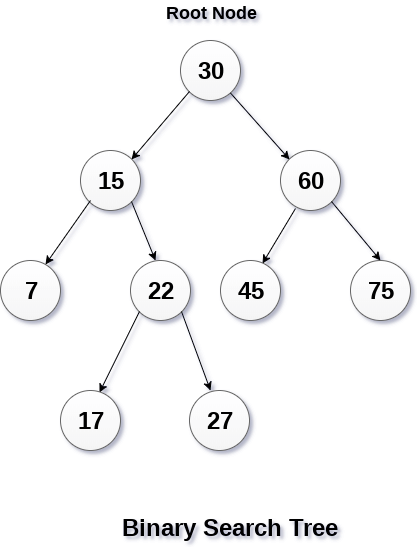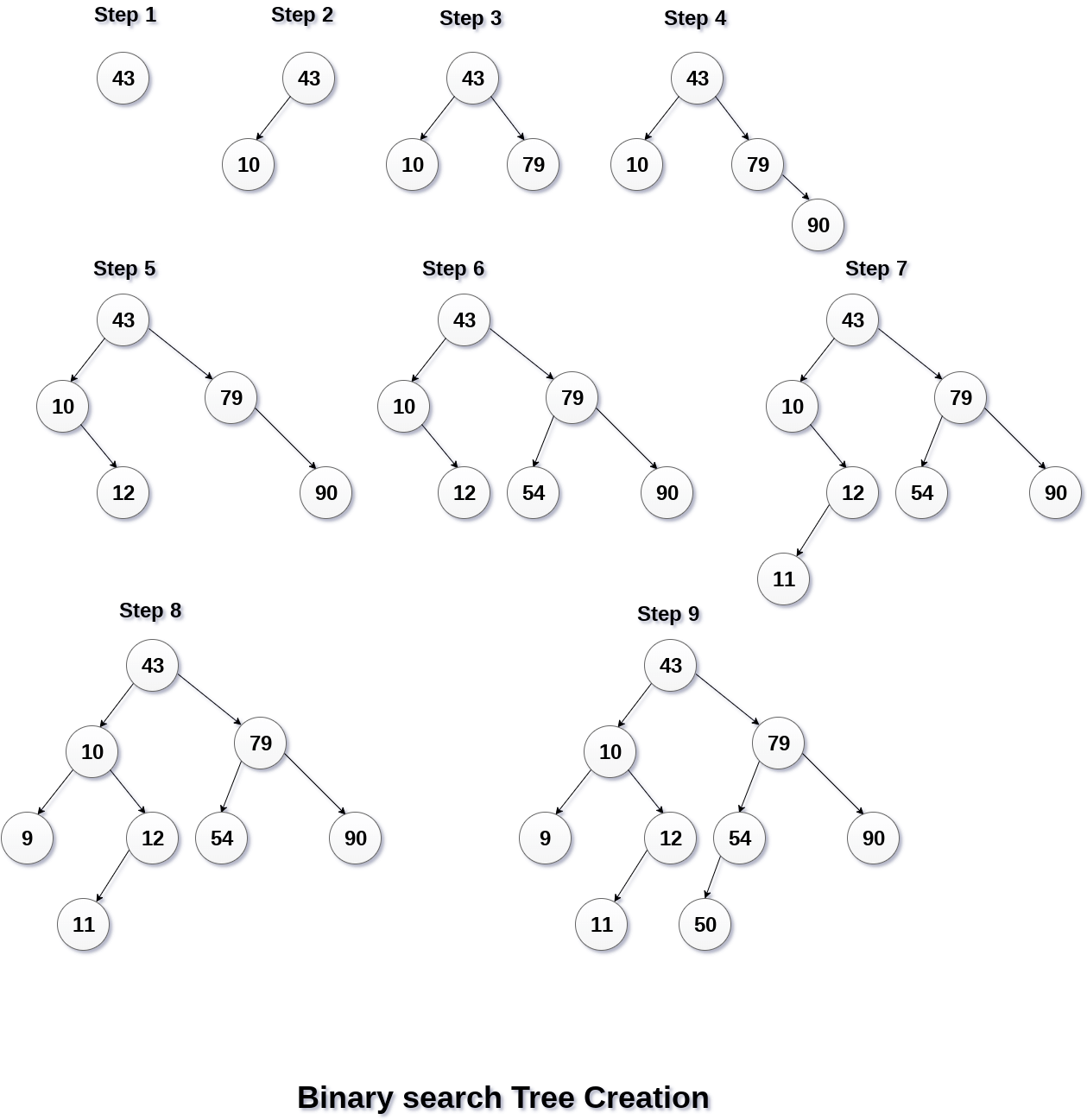TheDeveloperBlog.com
C-Sharp | Java | Python | Swift | GO | WPF | Ruby | Scala | F# | JavaScript | SQL | PHP | Angular | HTML
Binary Search Tree
Binary Search Tree with Introduction, Asymptotic Analysis, Array, Pointer, Structure, Singly Linked List, Doubly Linked List, Circular Linked List, Binary Search, Linear Search, Sorting, Bucket Sort, Comb Sort, Shell Sort, Heap Sort, Merge Sort, Selection Sort, Counting Sort, Stack, Qene, Circular Quene, Graph, Tree, B Tree, B+ Tree, Avl Tree etc.
Binary Search Tree

A Binary search tree is shown in the above figure. As the constraint applied on the BST, we can see that the root node 30 doesn't contain any value greater than or equal to 30 in its left sub-tree and it also doesn't contain any value less than 30 in its right sub-tree. Advantages of using binary search tree
Q. Create the binary search tree using the following data elements.43, 10, 79, 90, 12, 54, 11, 9, 50
The process of creating BST by using the given elements, is shown in the image below. 
Operations on Binary Search Tree
There are many operations which can be performed on a binary search tree.
Program to implement BST operations
#include <iostream>
#include <stdlib.h>
using namespace std;
struct Node {
int data;
Node *left;
Node *right;
};
Node* create(int item)
{
Node* node = new Node;
node->data = item;
node->left = node->right = NULL;
return node;
}
void inorder(Node *root)
{
if (root == NULL)
return;
inorder(root->left);
cout<< root->data << " ";
inorder(root->right);
}
Node* findMinimum(Node* cur)
{
while(cur->left != NULL) {
cur = cur->left;
}
return cur;
}
Node* insertion(Node* root, int item)
{
if (root == NULL)
return create(item);
if (item < root->data)
root->left = insertion(root->left, item);
else
root->right = insertion(root->right, item);
return root;
}
void search(Node* &cur, int item, Node* &parent)
{
while (cur != NULL && cur->data != item)
{
parent = cur;
if (item < cur->data)
cur = cur->left;
else
cur = cur->right;
}
}
void deletion(Node*& root, int item)
{
Node* parent = NULL;
Node* cur = root;
search(cur, item, parent);
if (cur == NULL)
return;
if (cur->left == NULL && cur->right == NULL)
{
if (cur != root)
{
if (parent->left == cur)
parent->left = NULL;
else
parent->right = NULL;
}
else
root = NULL;
free(cur);
}
else if (cur->left && cur->right)
{
Node* succ = findMinimum(cur- >right);
int val = succ->data;
deletion(root, succ->data);
cur->data = val;
}
else
{
Node* child = (cur->left)? Cur- >left: cur->right;
if (cur != root)
{
if (cur == parent->left)
parent->left = child;
else
parent->right = child;
}
else
root = child;
free(cur);
}
}
int main()
{
Node* root = NULL;
int keys[8];
for(int i=0;i<8;i++)
{
cout << "Enter value to be inserted";
cin>>keys[i];
root = insertion(root, keys[i]);
}
inorder(root);
cout<<"\n";
deletion(root, 10);
inorder(root);
return 0;
}
Output: Enter value to be inserted? 10 Enter value to be inserted? 20 Enter value to be inserted? 30 Enter value to be inserted? 40 Enter value to be inserted? 5 Enter value to be inserted? 25 Enter value to be inserted? 15 Enter value to be inserted? 5 5 5 10 15 20 25 30 40 5 5 15 20 25 30 40
Next TopicAVL Tree
|
Related Links:
- Binary Tree
- Binary Search Tree
- Binary Relation
- Binary Tree Preorder Traversal
- Binary Tree Inorder Traversal
- Binary Tree Postorder Traversal
- Binary Search


